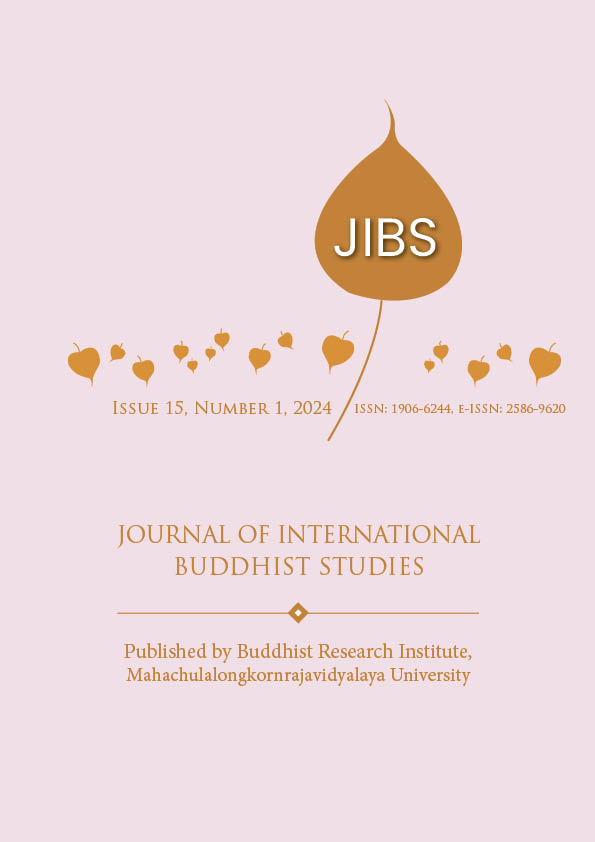On the Concept of “Lokāntarikā”
Keywords:
Lokāntarikā, Buddhist cosmology, Traiphum Phra Ruang, Death and Rebirth, HellAbstract
Lokāntarikā is one of the strangest places in the Buddhist cosmology. Typically understood as a hell, it is not located in any world system (cakravāla) but in the gap of three world systems. This article will discuss the narratives and depictions of lokāntarikā in early Buddhist canonical and Thai literature. The author argues that lokāntarikā mostly serves as a narrative device to highlight the miraculous qualities of the Buddha. The Traiphum Phra Ruang gives the most nuanced depiction of lokāntarikā, and lokāntarikā appears in Thai classical literature as a part of oath-taking.
References
Baker, Chris, & Phongpaichit, Pasuk. The Tale of Khun Chang Khun Phaen Abridged Version. Silkworm Books, 2015.
Bhikkhu Anālayo.. “Selected Madhyama-Āgama Discourse Passages and Their Pāli Parallels.” Dharma Drum Journal of Buddhist Studies19 (2016): 1–61.
Bhikkhu Sujato. Saṁyutta Nikāya: Linked Discourses. Sydney: Sutta Central. 2018.
———. Aṅguttara Nikāya: Numbered Discourses. Sydney: SuttaCentral. 2020.
———. Dīgha Nikāya: Long Discourses. Sydney: SuttaCentral. 2019.
Bingenheimer, Marcus. “The Suttas on Sakka in Agama and Nikaya Literature–With Some Remarks on the Attribution of the Shorter Chinese Samyukta Agama.” Buddhist Studies Review 25, (2008): 149-173.
Bodhisattva Nagarjuna. (2001). “Maha Prajnaparamita Sastra (Vol. 4).” Internet Archive. Accessed January 5, 2024, https://archive.org/details/mahaprajnaparamitasastravol4bybodhisattvanagarjunatripitakadharmacarya_893_s/mode/2up]
Bogle, James Emanuel. Buddhist cosmology: the study of a Burmese manuscript. Chiang Mai: Silkworm Books, 2016.
Bongard-Levin, Grigory Maksimovich. “New Buddhist Sanskrit Texts from Central Asia: An Unknown fragment of the Mahāyāna Mahāparinirvāṇasūtra.” Journal of the International Association of Buddhist Studies (1981): 7-16.
Buddhaghosa, Bhadantacariya. The Path of Purification: Visuddhimagga. Translated by Bhikkhu Ñāṇamoli. Kandy: Buddhist Publication Society, 2010.
Patton, Chloe. “The Long Discourses | 1. The Great Legend.” Dharma Pearls. Accessed January 5, 2024, https://canon.dharmapearls.net/01_agama/dirgha/DA_1.html#n2.
Punnadhammo Mahāthero. The Buddhist Cosmos. Ontario: Arrow River Forest Hermitage, 2018.
Cowell, Edward Byles, ed. The Jataka, Vol. VI. Cambridge: Cambridge University Press, 1907.
Gupta, Ravi, and Kenneth Valpey. The Bhagavata Purana: Sacred Text and Living Tradition. Columbia University Press, 2013.
Hiraoka Satoshi. “Text Critical Remarks On the Divyāvadāna (1).” Annual Report of the International Research Institute for Advanced Buddhology at Soka University 12 (2008): 29–72.
———. “The Relation Between the ‘Divyāvadāna’ and The Mūlasarvāstivāda Vinaya.” Journal of Indian Philosophy 26, (1998): 419–434.
Huntington, Eric. “Buddhist Cosmology.” Oxford Research Encyclopedia of Religion, 2022.
Jones, John James. The Mahavastu (Vol. 1). London: Luzac, 1949.
Kumagai Yasunao. “A Study of the Mandhatavadana-The Gilgit Manuscript.” Journal of Indian and Buddhist Studies (Indogaku Bukkyogaku Kenkyu) 41, (1992): 463–460.
King Lithai. Traibhumikatha, the Story of the Three Planes of Existence. Translated by The Thai National Team. Bangkok: The Asean Committee on Culture and Information, 1985.
———.Traiphum Katha [Sermon on the Three Worlds]. Bangkok: Department of Fine Arts, Thailand, 1983.
Mabbett, Ian. “Cosmography, Architecture and Ritual in Hindu‐Buddhist Culture.” South Asia: Journal of South Asian Studies 6, (June 1, 1983): 44–53. Doi: https://doi.org/10.1080/00856408308723041.
Mahāsaṅgīti Tipiṭaka Buddhavasse 2500. 40 volumes. Bangkok: M.L. Maniratana Bunnag Dhamma Society Fund, 2005.
Namphueng Padamalangula. “Framing the Universe: Cosmography and the ‘Discourse on the Frame’ in Traiphum Phra Ruang.” Rien Thai 1, (2008): 71–85.
Niyada Laosoontorn. Trai phum phra ruang: gansueksathima [Study of Sources of Triphum Praruang]. Bangkok: Maedampang, 1995.
Reynolds, Frank E., and Mani B. Reynolds. Three Worlds According to King Ruang: A Thai Buddhist Cosmology. Berkeley: University of California Press, 1982.
Sadakata Akira. Buddhist Cosmology: Philosophy and Origins. 1st English ed. Tokyo: Kosei Publishing Company, 1997.
Bando, Shoku. “Reasoning on the formation process of lokantarika-niraya.” Journal of Indian and Buddhist Studies 29, (1980): 126-127. Doi: https://doi.org/10.4259/ibk.29.126.
Soothill, William Edward, and Lewis Hodous, eds. A dictionary of Chinese Buddhist terms: with Sanskrit and English equivalents and a Sanskrit-Pali index. Motilal Banarsidass Publ., 1977.
Junjirō, Takakusu, and Watanabe Kaikyoku. Taishō shinshū daizōkyō [Buddhist Canon Newly Compiled under the Taishō era (1912–1926)] (100 volumes). Tokyo: Taishō Issaikyō Kankōkai 大正一 切經刊行會. 1932.
Fukita, Takamichi, ed. The Mahāvadānasūtra: a new edition based on manuscripts discovered in Northern Turkestan. Vol. 10. Vandenhoeck & Ruprecht, 2003.
Tambiah, Stanley J. “The Buddhist Cosmos: Paradise Lost, Gained, and Transcended.” In F. Reynolds & M. B. Reynolds (Eds.), History of Religions 24, (1984): 73–81.
Vaidya, Paraśurāma Lakshmaṇa. The Divyavadana. Darbhanga: Mithila Institute of Post-graduate Studies and Research in Sanskrit Learning, 1959.
Van Put, Ineke. “The Names of Buddhist Hells in East Asian Buddhism.” Pacific World: Journal of the Institute of Buddhist Studies, (2007): 205-239.







